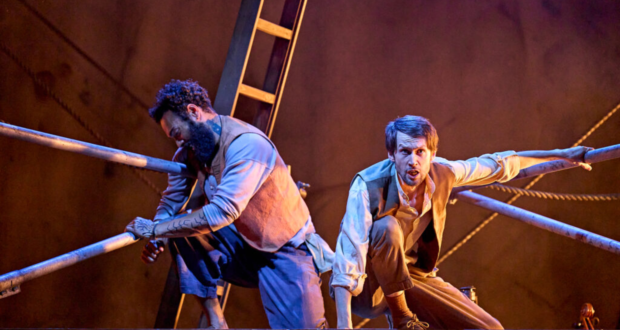Imaginative and innovative staging help provide amazing visuals Summary
Rating
Good
“Call me Ishmael.”
And so, like the book, Simple8 begin their version of Herman Melville’s masterpiece. Adapted by Sebastian Armesto, directed by Jessie Jones, and told with music and song (sea shanties of course!) Moby Dick starts by telling the story of Ishmael (Mark Aernds), a schoolteacher who has decided to go to sea to hunt whales. We follow him as he searches for a ship and climbs to the crow’s nest of the whaling ship Pequod, scanning the horizon for the sight of a whale. But, as we all know, the real story is of Captain Ahab (Guy Rhys) and his descent into madness, where every waking moment is spent hunting the great white whale, Moby Dick.
Starting with an almost empty stage the cast builds up the set as they go along, with planks of wood transforming into pub bars, gangways, ship decks, and even rowing boats. The shape of the Pequod comes together in a brilliant moment as scaffolding, wood, and rope are moved into place, clearly depicting the bow of a ship. There are several moments like this where jaw-dropping staging steals the limelight; it is thoroughly impressive. A particular highlight, and a visual to remember, sees the ensemble creating the image of a whale with pieces of wood in a real moment of magic. Huge credit to designer Kate Bunce.
The novel is around 550 pages, so an adaptation was always going to leave a lot out. Armesto does manage to smartly include some of the biology and history of whales that the book takes extensive detours into, but leaves out much on the book’s other themes like, faith and class and race. As a result of this, the deep friendship between Ishmael and Queequeg (Tom Swale) is underexplored, leaving the latter’s death less impactful.
Then as the Pequod changes course, determined to find the great white whale, the story goes flat. There are many raised voices, with Ahab in particular shouting a lot, but this doesn’t actually raise the intensity or create any tension. We don’t get a clear insight into Ahab’s drive, his hunt for the white whale. Similarly, the impact on the crew of the Pequod fails to come across: everything here feels like it needs to be intensified. For a story set almost entirely at sea, we only scratch the surface; we do not dive into the depths.
Fortunately, the excellent staging, combined with music and sea shanties (by Jonathan Charles, played on an assortment of musical instruments, and sung by the ensemble, with a standout performance by William Pennington), makes this a worthy endeavour. For the finale, the ensemble comes together with simple props and some physical theatre to lower the rowboats and embark on the hunt for the great whale, in another hugely effective visual that leads us to the end of the story and the end of the Pequod. It’s a theatrical experience that stays afloat in the audience’s memory long after the ship sinks and Moby Dick swims away into the night.
Based on the book by Herman Melville
Adapted by Sebastian Armesto
Directed by Jessie Jones
Composer & Musical Director Jonathan Charles
Designer Kate Bunce
Presented by Simple8 in association with Royal & Derngate, Northampton
Moby Dick plays at Wilton’s until 11 May. Further information and bookings can be found here. It then continues on tour until June, venues and dates available here.
 Everything Theatre Reviews, interviews and news for theatre lovers, London and beyond
Everything Theatre Reviews, interviews and news for theatre lovers, London and beyond



